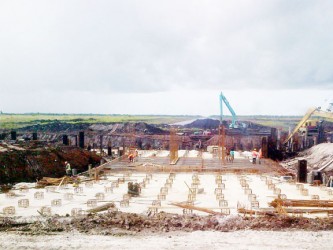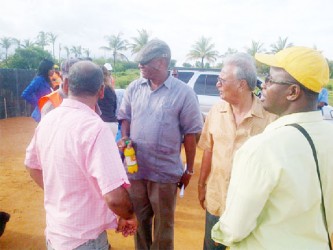The Hope Canal Project will not be completed by its extended August 31st, 2013 deadline as previously intended, Agricultural Minister Leslie Ramsammy announced yesterday, while giving assurances that the need for an extension for the project will not require additional funding.
Conceived following the Great Flood of 2005, the controversial project will drain water from the East Demerara Water Conservancy (EDWC) into the Atlantic Ocean, thereby eliminating the flooding of the Mahaica Creek and its environs.
Ramsammy made the revelation of the extension of the deadline when the Parliamen-tary Sectoral Committee on Natural Resources, in keeping with its 2013 work programme, visited the EDWC and the Hope Canal to examine the progress of the work at its key installations: the Head Regulator (HR), the Bridge, and High Level Sluice Outfall Structure (HLSOS) at the Atlantic Ocean.

A Partnership for National Unity (APNU) MP Joe Harmon, one of the committee’s members, yesterday said that information provided and explanations given had suggested that the project may not be completed by the projected date. This perception was shared by several other members of the committee, including APNU MP Rupert Roopnaraine and Alliance for Change (AFC) MP Trevor Williams after they had inspected the various project sites.
Harmon said, “We have been given indications from the engineers and contractors that the HR and the indoor sluice (HLSOS) should have been completed by the 31st of August but the engineers and persons from BK have said that it will not be finished before December.
Roopnaraine said that in his opinion, “An August completion is out of the question,” since it seemed that at least eight to ten months of work would be needed to complete the project.
Speaking to Stabroek News, Ramsammy said, “I would have wished we could have completed this project on the stipulated deadline of August 31st, but the fact is there will be an extension of that deadline.” The minister added, though, that there will be no need to request supplementary funds for the project since they have managed to stay within the $3 billion budget the project was assigned.
Following a February 14, 2012 editorial in Stabroek News stating that Hope Canal might not be functional until 2014, Ramsammy had said in a letter in response “The project will be completed in 2013 and we are confident, even with any slippage, that it would be functional in 2013 and not 2014. The conclusion by SN is reckless, if not mischievous.”
Harmon said that his major concern was the possibility of having to disburse additional funding to facilitate the completion of the project.

Harmon added that inclement weather has been cited by engineers, contractors, and even officials from the National Drainage and Irrigation Authority (NDIA) as one of the more significant road-blocks they have had to deal with. The weather was particularly instrumental in slowing works to the HR and the HLSOS, Harmon said, while Roopnaraine, who noted that the work relating to the head regulator had encountered the most challenges, said that getting the required machinery in and out of the EDWC and the removal of pegasse were among the issues which plagued this leg of the project.
The need for the additional time is likely more geared towards the facilitation of whatever work needs to be done to the HR and the HLSOS in particular, since these are the project components furthest behind schedule. Speaking to Stabroek News last month, Lionel Wordsworth, Chief Executive Officer of the NDIA, had said that the HR was just 34% completed, while HLSOS was 33% completed.
In contrast, he said then that the excavation of the canal itself was 90% completed, with various other associated works such as trimming and shaping the embankment, stockpiling and draining suitable clay for construction of the embankment, the installation of geotextile as well as construction of alternative drainage channels being 53% completed. The other major component – the public road bridge – was 79% completed.
Minister Ramsammy yesterday explained that the canal could not be fully excavated since the remaining sections are dependent on the completion of the other structures (the HR and the HLSOS). “The canal cannot be taken to the conservancy until the HR is completed and the canal cannot be taken to the HLSOS until it is completed,” he said.
Roopnaraine, who said that initially he was not an enthusiast of the canal, shared that he had lingering concerns, particularly the nature of construction of the project components so close to the Hope Secondary School.
He said nevertheless, that he was happy at the work that was being done, and lauded the way in which the contractors and engineers have addressed the many challenges which they have faced.
Williams on the other hand, described the exercise as invaluable.
As opposed to going through a 400-page document, he said, the one-on-one interactions with the engineers, paired with being able to see the ongoing work, goes a far way in helping the members of the committee to understand the specifics of the project. He said though, that he hopes a follow-up visit, probably in a couple of months, could be organised as the committee continues to gauge the progress being made. Harmon also said that the examination was very helpful, and said that if there is need for additional explanations, it can be requested of the minister at the level of the committee.
Meanwhile, Ramsammy said that he was happy that the committee was able to inspect the project sites. “On their visit here they would have seen three things; real work has been done, we have stayed within the budgetary allocation, and Guyanese workers have been the ones doing the work,” the minister said.
Apart from Williams, Roopnaraine and Harmon, the Parliamentary Sectoral Committee on Natural Resources is also comprised of PPP/C MPs Odinga Lumumba, Neil Kumar, Cornel Damon, APNU MP Vanessa Kissoon and PPP/C MP Komal Chand. Roopnaraine functions as its Chairman while Lumumba serves as Vice Chair.








